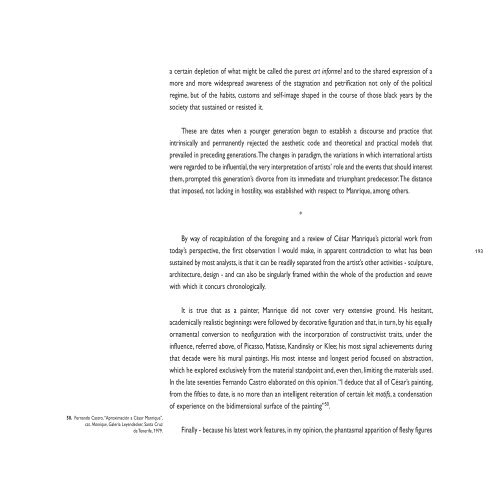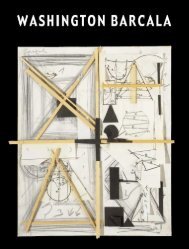VERSIÓN INGLESA ENGLISH VERSION - Fundación César Manrique
VERSIÓN INGLESA ENGLISH VERSION - Fundación César Manrique
VERSIÓN INGLESA ENGLISH VERSION - Fundación César Manrique
Create successful ePaper yourself
Turn your PDF publications into a flip-book with our unique Google optimized e-Paper software.
50. Fernando Castro, “Aproximación a <strong>César</strong> <strong>Manrique</strong>”,<br />
cat. <strong>Manrique</strong>, Galería Leyendecker, Santa Cruz<br />
de Tenerife, 1979.<br />
a certain depletion of what might be called the purest art informel and to the shared expression of a<br />
more and more widespread awareness of the stagnation and petrification not only of the political<br />
regime, but of the habits, customs and self-image shaped in the course of those black years by the<br />
society that sustained or resisted it.<br />
These are dates when a younger generation began to establish a discourse and practice that<br />
intrinsically and permanently rejected the aesthetic code and theoretical and practical models that<br />
prevailed in preceding generations. The changes in paradigm, the variations in which international artists<br />
were regarded to be influential, the very interpretation of artists’ role and the events that should interest<br />
them, prompted this generation’s divorce from its immediate and triumphant predecessor. The distance<br />
that imposed, not lacking in hostility, was established with respect to <strong>Manrique</strong>, among others.<br />
*<br />
By way of recapitulation of the foregoing and a review of <strong>César</strong> <strong>Manrique</strong>’s pictorial work from<br />
today’s perspective, the first observation I would make, in apparent contradiction to what has been<br />
sustained by most analysts, is that it can be readily separated from the artist’s other activities - sculpture,<br />
architecture, design - and can also be singularly framed within the whole of the production and oeuvre<br />
with which it concurs chronologically.<br />
It is true that as a painter, <strong>Manrique</strong> did not cover very extensive ground. His hesitant,<br />
academically realistic beginnings were followed by decorative figuration and that, in turn, by his equally<br />
ornamental conversion to neofiguration with the incorporation of constructivist traits, under the<br />
influence, referred above, of Picasso, Matisse, Kandinsky or Klee; his most signal achievements during<br />
that decade were his mural paintings. His most intense and longest period focused on abstraction,<br />
which he explored exclusively from the material standpoint and, even then, limiting the materials used.<br />
In the late seventies Fernando Castro elaborated on this opinion. “I deduce that all of <strong>César</strong>’s painting,<br />
from the fifties to date, is no more than an intelligent reiteration of certain leit motifs, a condensation<br />
of experience on the bidimensional surface of the painting” 50 .<br />
Finally - because his latest work features, in my opinion, the phantasmal apparition of fleshy figures<br />
193
















![Becas y premios de la Fundación César Manrique [1997-2006]](https://img.yumpu.com/20766851/1/184x260/becas-y-premios-de-la-fundacion-cesar-manrique-1997-2006.jpg?quality=85)
